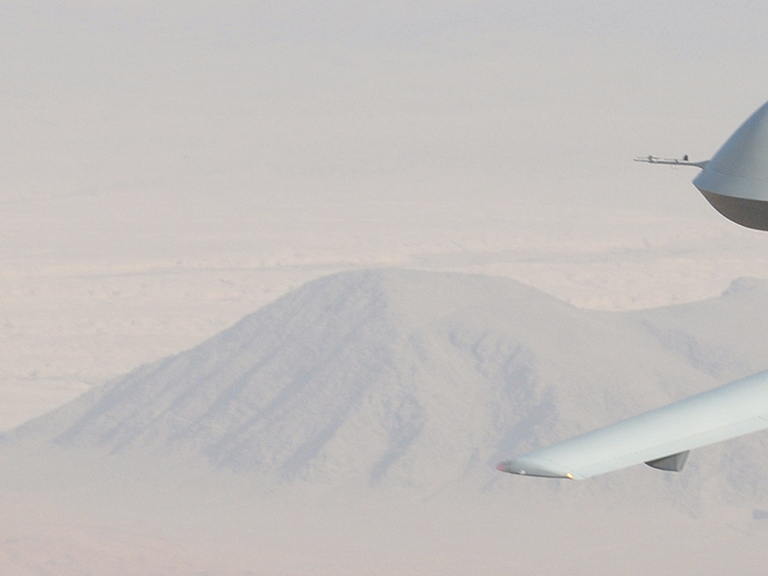An interview with Jameel Jaffer, who helped force the Obama Administration to release documents underlying its campaign of targeted killings
FAHIM QURESHI was nearly fourteen when the first drone strike authorized by President Obama struck his family home in the North Waziristan region of Pakistan, wounding him and killing two of his uncles and a cousin. Still, 8 years later, at 22, this “act of tyranny” is the only thing Qureshi knows about the Obama administration.
Qureshi never received an apology from the Obama administration. The drone strike and its aftermath were never publicly acknowledged, although one person close to the President says his body language suggested “he was not a happy man” after hearing about civilian casualties.
Indeed, in the eight years of Obama's term of office, civilian deaths at the hands of drone strikes have been followed by official silence. Occasionally this pattern is interrupted by lawsuits on behalf of the victims, but so far, courts have refused to provide judicial oversight.
There have been some successes in forcing the Obama administration to be more transparent. Multiple lawsuits filed by the American Civil Liberties Union (ACLU) and others have led to the release of some legal and policy documents underlying the campaign of targeted killings in the past few years. Even while these documents do nothing to limit Obama’s drone strikes or prevent new ones, they do shed some light on the legal and political architecture that the Obama administration has laid in place for the next president to take over.
The dangers of unconstrained executive powers claimed by the Obama administration becomes more pronounced now that these extraordinary powers will be in the hands of President Trump, a man whose campaign thrived on colloquial promises to “bomb the shit” out of anyone he determined a threat.
These dangers are highlighted in the documents collected in The Drone Memos: Targeted Killing, Secrecy, and the Law, introduced and edited by Jameel Jaffer, and published this month by The New Press. Jaffer, who led the American Civil Liberties Union’s (ACLU) legal team that fought for the release of the once-secret memos, spoke with The New Inquiry about the Obama administration’s creative justifications for its targeted killing program, its potential consequences, and the limitations of the law.

You note in the introduction that the Obama administration adopted the Bush administration’s claim that the U.S. had the authority to use military force “away from the zone of active hostilities” in countries which consented or proved “unable or unwilling” to take action themselves. Is there any precedent for claiming the executive authority to take military action anywhere in the world?
This is an important point. The Bush administration argued that the entire planet should be considered a battlefield. Relying on this theory, it detained José Padilla (a U.S. citizen) and Ali al-Marri (a U.S. resident) as “enemy combatants” inside the U.S. This was immensely controversial at the time. President Obama abandoned the rhetoric of global war but some of the legal arguments his administration has made are precisely the same ones that the Bush administration made. The Bush administration relied more heavily on the president’s constitutional authority as commander in chief, whereas the Obama administration has relied more heavily on a very broad reading of statutory law and, in particular, the Authorization for Use of Military Force that Congress passed in the wake of the 9/11 attacks. But the Obama administration has adopted the theory that the war against al-Qaeda and its affiliates is a borderless one. It’s a concept that virtually no other country has accepted, and one whose long-term implications may be very significant. I think the notion that the war is everywhere is a notion that people rightly resist. The government has very broad powers to use lethal force during war times and in war zones. Precisely because those powers are so broad, it’s very important to contain the legal space within which war powers can be invoked.
Have you noticed any evolution of these legal arguments from the Bush administration to the Obama administration?
Yes, the legal arguments have changed -- or at least the emphasis has changed. The Bush administration relied very heavily on the president’s constitutional powers as commander in chief. The Obama administration hasn’t disavowed that argument, but it has interpreted statutory law so broadly that it hasn’t had to rely on it. As a practical matter, there’s very little space between the power the Bush administration claimed and the power the Obama administration is now claiming. In that sense, there hasn’t really been an evolution. To the contrary, there has been a surprising continuity between the two administrations.
There is one place where there’s been a kind of evolution. President Obama authorized a dramatic expansion of the drone campaign, but over the past three years there has been an effort on the part of the administration to develop administrative processes to regulate the campaign. The 2013 Presidential Policy Guidance, which was released recently in response to litigation brought by the ACLU, sets out both substantive targeting rules as well as administrative processes that the government generally follows in authorizing and carrying out drone strikes. I have conflicting feelings about this document. On the one hand, if the U.S. is going to be carrying out drone strikes in places far removed from actual hostilities, we should have a set of public rules that explain why such strikes are being carried out, and who’s authorizing them. On the other hand, the existence of this document is evidence of the extent to which targeted killing has become normalized. Historically, the U.S. characterized targeted killings as assassinations or even war crimes. Now, we have a whole bureaucracy dedicated to authorizing and carrying out such killings.
We know from news reports that the people targeted and affected are not limited to al-Qaeda and associated forces. Who exactly does the Obama administration claim it can target in these strikes?
The administration draws a distinction between areas of actual hostilities and other areas. In what it calls areas of actual hostilities, it uses rules drawn from the laws of war. In other areas, like Yemen and Somalia, it generally uses more stringent rules, which are spelled out in the Presidential Policy Guidance that President Obama signed in the spring of 2013. Controversially, the administration applies these more stringent rules as a matter of discretion and not because it believes they are legally mandated. Moreover, some of the key terms in the Presidential Policy Guidance -- terms like “continuing and imminent threat” -- aren’t defined with any precision. The Presidential Policy Guidance is also full of exceptions.
You write that disclosures about drone strikes have almost always been a matter of “executive grace.” Courts have also accepted some of the government’s arguments regarding targeted killings that they previously rejected in cases regarding detention. What do you think explains the reluctance of courts to force the administration to be more transparent?
Many of the documents that I collect in the book were released in response to the Freedom of Information Act (FOIA) litigation. If it hadn’t been for the litigation, the administration probably wouldn’t have released them. But the litigation didn’t actually compel the government to release anything. The administration decided not to appeal certain things and even when the courts ruled against the administration, they did so only after having concluded that the administration had already released -- “officially acknowledged” is the term of art -- the information that it was refusing to disclose. So my overall view is that the FOIA turned out to be a relatively weak tool to force transparency in this context. Not useless, but weak. At the end of the day, the executive branch had nearly complete control over what was released, when it was released, and how it was released.
You talk about how the Obama administration has redefined the word “imminent” to refer to pretty much any threat. Another word now stretched beyond any meaning is “self-defense.” It seems that the drone program has led to legal changes that have consequences far beyond the campaign of targeted killings. What are the potential implications of these legal innovations?
That American courts were unwilling to consider the lawfulness of drone strikes is very troubling, but this was part of a larger pattern. National security policy is insulated from judicial review by a whole slew of procedural and jurisdictional doctrines. The result is that many of the controversial national security policies that were adopted over the past 15 years have never been subject to judicial review on the merits. That’s a real problem. One day there will be an administration that will want, for example, to revive the torture program or vastly expand the drone campaign and there will be no precedent on the books preventing it from doing so. On counterterrorism policy, the courts have been more or less AWOL. With few exceptions, the courts have stood by while the executive branch claimed authorities that even a generation ago would’ve been viewed as beyond the pale.
In dismissing a case involving Anwar and Abdulrahman al-Awlaki and Samir Khan -- all U.S. citizens and targeted by the Obama administration -- Judge Collyer of the U.S. District Court in Washington wrote that the judiciary has “an exceedingly limited role” when it comes to national security. Do you think it’s possible to legally challenge the drone program without also challenging our endless and borderless war on terror?
It’s important to recognize that the cases we brought weren’t challenges to the drone campaign as such, but rather to the lawfulness of specific strikes that killed specific people. The frustrating thing about that passage from Judge Collyer’s opinion is that, while it may very well be true that American courts have a limited role with respect to issues of national security and war, that limited role surely encompasses protecting the constitutional rights of American citizens. I would argued that the courts’ role is broader, but if courts don’t step in even when Americans’ constitutional rights and lives are at stake, it’s hard to see the argument that they’re doing their job.
But given that there seems to be no legal redress when it comes to drone strikes, should we not be focusing our efforts outside the legal system?
Perhaps that’s one message of these cases. Perhaps it’s foolish to think American courts are going to limit the powers the executive branch says it needs to fight the war on terror. But I guess I’m still hopeful, perhaps naively, that the courts will reclaim the role that the constitution envisioned for them in this context. At the same time, I don’t think we’re going to see significant changes to counterterrorism policy without significant political pressure from both inside and outside the country. There’s a role for litigation, but litigation will never be effective unless it’s part of a broader strategy.
